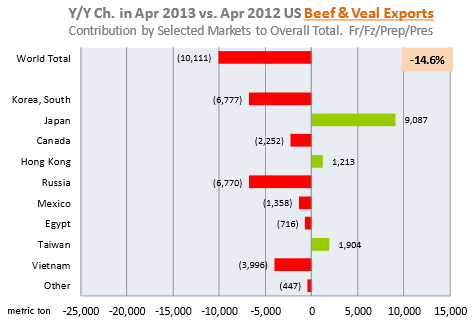



CME: Decline in April Red Meat Exports
US - The April red meat export numbers had few good news for US beef and pork producers, write Steve Meyer and Len Steiner.Exports of fresh/frozen and cooked beef in April were 59,267 MT, 14.6 per cent lower than a year ago and the sixth consecutive month that beef exports have regis- tered a decline compared to the previous year. Shipments of fresh/ frozen and cooked pork in Ap ril were 134,009 MT, 10.5 per cent lower than a year ago and the sixth consecutive month that US pork exports have registered a decline compared to the previous year. Chicken exports rose 3.2 per cent in April.
The decline in beef exports is broad based (see chart). While Russia has been in headlines due to its ban on US beef over ractopamine, exports to markets such as South Korea and Vietnam also notably impacted US beef trade in April. Beef exports to South Korea were 5,621 MT in April, down some 6,777 MT or 55 per cent from a year ago.

The decline in exports to S. Korea could in part be due to a stronger US currency, increased competition for product from Japan (and higher prices as a result) and also more competitive beef of fers from other markets, particularly Australia. Australia exports to S. Korea in March were 42 per cent higher than the previous year and they rose 27 per cent in April and 36 per cent in May.
Beef exports to Viet Nam have also slowed down. The decline in exports to Vietnam has come at a time when China has significantly ramped up its beef imports from the rest of the world. Keep in mind that China, similar to Russia, does not allow US beef imports due to ractopamine residue regulations. And different from pork, most US beef suppliers cannot supply ractopamine-free beef. China has now beco me the third largest buyer of Australian beef, with Australian shipments there up 35 fold compared to a year ago. China also has become the biggest buyer of Uruguayan beef and it is actively trying to source beef from other areas (Hong Kong is also buying big quantities from Brazil). Some US beef that likely was finding its way into China via other markets now is finding it more difficult to do so given more stringent import controls there.
US beef exports to Russia are almost non-existent and this has significantly impacted overall US beef volume for the month. The only bright light for beef exports has been Japan, with shipments to that market up 96 per cent from a year ago. The rise in exports to Japan in part reflects some pent up demand for US beef. While the weak Yen is a negative for beef trade, Japanese demand for relatively low value beef cuts, such as plates, brisket and chuck is significant and current pricing in the US remains competitive with other markets, especially when considering the preference in Japan for US grain fed beef.
Pork exports have been significantly impacted by Russian decision to stop purchases of US pork products. Exports to Russia were down almost 10,000 MT in April, accounting for a good portion of the 15,789 MT decline in overall US pork exports.
Exports to Japan, the second largest market for US pork in April, were down almost 4000 MT or 11 per cent from a year ago. The strong US dollar and trade distorting regulations have negatively impacted shipments to this market. Pork exports to China/Hong Kong remain notably weaker than a year ago, with shipments in April down 34 per cent from a year ago. Pork exports to Mexico increased, which is consistent with reports of more active Mexico buying of US hams. Year to date, US pork exports are down 14 per cent from a year ago.









